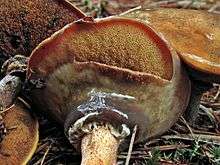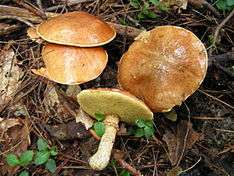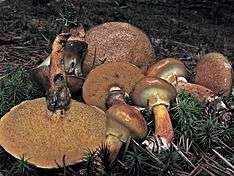Suillus salmonicolor
Suillus salmonicolor, commonly known as the slippery Jill, is a fungus in the family Suillaceae of the order Boletales. First described as a member of the genus Boletus in 1874, the species acquired several synonyms, including Suillus pinorigidus and Suillus subluteus, before it was assigned its current binomial name in 1983. It has not been determined with certainty whether S. salmonicolor is distinct from the species S. cothurnatus, described by Rolf Singer in 1945. S. salmonicolor is a mycorrhizal fungus—meaning it forms a symbiotic association with the roots of plants such that both organisms benefit from the exchange of nutrients. This symbiosis occurs with various species of pine, and the fruit bodies (or mushrooms) of the fungus appear scattered or in groups on the ground near the trees. The fungus is found in North America (including Hawaii), Asia, the Caribbean, South Africa, Australia and Central America. It has been introduced to several of those locations via transplanted trees.
The mushroom's dingy yellow to brownish cap is rounded to flattened in shape, slimy when wet, and grows up to 9.5 cm (3.7 in) wide. The small pores on the underside of the cap are yellow before becoming olive-brown. The stem is up to 10 cm (3.9 in) long and 1.6 cm (0.6 in) thick and is covered with reddish-brown glandular dots. Young specimens are covered with a grayish, slimy partial veil that later ruptures and leaves a sheathlike ring on the stem. Although the mushroom is generally considered edible—especially if the slimy cap cuticle and partial veil are first peeled off—opinions about its palatability vary. Other similar Suillus species include S. acidus, S. subalutaceus, and S. intermedius.
Taxonomy and phylogeny
The species was first described scientifically by American mycologist Charles Christopher Frost in 1874 as Boletus salmonicolor, based on specimens he collected in the New England area of the United States.[10] In a 1983 publication, mycologist Roy Halling declared Boletus subluteus (described by Charles Horton Peck in 1887;[4] Ixocomus subluteus is a later combination based on this name[5]) and Suillus pinorigidus (described by Wally Snell and Esther A. Dick in 1956[9]) to be synonymous. Halling also reexamined Frost's type specimen of B. salmonicolor, and considered the taxon better placed in Suillus because of its glutinous cap, dotted stem, and ring; he formally transferred it to that genus, resulting in the combination Suillus salmonicolor.[2] The specific epithet salmonicolor is a Latin color term meaning "pink with a dash of yellow".[11] The mushroom is commonly known as the "slippery Jill".[12]
| |||||||||||||||||||||||||||||||||||||||||||||
| Phylogenetic relationships of S. salmonicolor (as S. subluteus) and related species based on ITS sequences.[13][14] |
In a 1986 publication on Suillus taxonomy and nomenclature, Mary E. Palm and Elwin L. Stewart further discussed the synonymy of S. salmonicolor, S. subluteus, and S. pinorigidus. They noted that fruit bodies of S. subluteus collected in Minnesota did not have the strong salmon colors considered characteristic of S. salmonicolor, as well as collections that had been named S. pinorigidus; this is a morphological difference that could be sufficient to consider S. subluteus a distinct species. They explained that although the microscopic characteristics of the three taxa do not differ significantly, this is not unusual for Suillus and cannot be used as the sole proof of conspecificity. Palm and Stewart concluded that a study of specimens from various areas of their geographical ranges would be needed to fully resolve the taxonomy of these related species.[15]
There is some disagreement in the literature about whether Suillus cothurnatus represents a different species from S. salmonicolor. The online mycological taxonomy database MycoBank lists them as synonyms,[1] contrary to Index Fungorum.[16] In their 2000 monograph of North American boletes, Alan Bessette and colleagues list the two taxa separately, noting that the range of S. cothurnatus is difficult to determine because of confusion with S. salmonicolor.[17] In a molecular analyses of Suillus phylogeny, based on the internal transcribed spacer, S. salmonicolor (as S. subluteus) and S. intermedius clustered together very closely, indicating a high degree of genetic similarity.[13][14] These analyses were based on comparing the sequence differences in a single region of ribosomal DNA; more recent molecular analyses typically combine the analysis of several genes to increase the validity of inferences drawn.[18]
Description

The cap of S. salmonicolor is bluntly rounded or convex to nearly flattened, reaching a diameter of 3–9.5 cm (1.2–3.7 in). The cap surface is sticky to slimy when moist, but becomes shiny when dry. The cap color is variable, ranging from dingy yellow to yellowish-orange to ochraceous-salmon, cinnamon-brown or olive-brown to yellow-brown. The flesh is pale orange-yellow to orange-buff or orange, and does not stain when exposed to air. The odor and taste are not distinctive. The pore surface on the underside of the cap is yellow to dingy yellow, or yellowish orange to salmon, darkening to brownish with age; it also does not stain when bruised. The pores are circular to angular, measuring 1–2 per mm and 8–10 mm (0.3–0.4 in) deep. The stem is 2.5–10 cm (1.0–3.9 in) long, 6–16 mm (0.2–0.6 in) thick, and either equal in width throughout or slightly enlarged in the lower portion. It is whitish to yellowish or pinkish-ochre, and has reddish-brown to dark brown glandular dots and smears on the surface. Glandular dots are made of clumps of pigmented cells, and, unlike reticulation or scabers (small visible tufts of fibers that occur on the stems of other Suillus species), can be rubbed off with handling. The flesh is ochraceous to yellowish, often salmon-orange at the base of the stem. The partial veil that protects the developing gills is initially thick, baggy, and rubbery. It often has a conspicuously thickened cottony roll of tissue at its base, and sometimes flares outward from the stem on the lower portion. It forms a gelatinous ring on the upper to middle part of the stem. The spore print is cinnamon-brown to brown.[12] The surface of the cap, when applied with a drop of dilute potassium hydroxide (KOH) or ammonia solution (chemical reagents commonly used for mushroom identification), will first turn a fleeting pink color, then dark red as the flesh collapses.[19]
The spores are smooth, roughly ellipsoid in shape, inequilateral when viewed in profile, and measure 7.6–10 by 3–3.4 μm. They appear hyaline (translucent) to yellowish in a dilute solution of KOH, and cinnamon to pale ochraceous when stained with Melzer's reagent. The basidia are somewhat collapsed, hyaline, and 5–6 μm thick. The cystidia are scattered, sometimes arranged in clusters (especially on the gill edge), usually with an ochraceous-brown content, but occasionally hyaline. They are club-shaped to somewhat cylindric and measure 34–60 by 10–13 μm. The cuticle of the cap is an ixotrichodermium—a cellular arrangement where the outermost hyphae are gelatinous and emerge roughly parallel, like hairs, perpendicular to the cap surface. These hyphae are hyaline and narrowly cylindric, measuring 1.4–3 μm in diameter. The stem surface is made of scattered bundles of caulocystidia (cystidia on the stem) that are brown or sometimes hyaline in KOH, club-shaped to subcylindrical bundles interspersed among hyaline cells. These bundles are underlain by a layer of gelatinous, hyaline, vertically oriented and parallel hyphae that are shaped like narrow cylinders. Clamp connections are absent from the hyphae.[2]
Edibility
The mushroom is edible, but removal of the slimy cap cuticle and partial veil is recommended to avoid possible gastrointestinal upset;[20] similarly, the 1992 field guide Edible Wild Mushrooms of North America recommends the removal of the tube layer before preparation, as it can become slimy during cooking.[21] Opinions about the quality of the mushroom vary. According to the book Boletes of North America, it is "very good" with a "lemony" flavor.[12] A Canadian field guide is more cautious in its assessment, and suggests that one would have to be brave to consume a mushroom with such a sticky veil.[22] Mycologist David Arora, in his Mushrooms Demystified, opines that it is not worth eating.[23] Whatever its palatibility to humans, the mushroom serves as a habitat for larvae of mycophagous insects such as the muscid fly Mydaea discimana and the scuttle fly Megaselia lutea.[24]
Similar species


Suillus intermedius, found in northeastern and northern North America,[25] is similar in appearance to S. salmonicolor. It may be distinguished by a lighter-colored cap, cream to yellowish or pale ochraceous flesh, and a ring that is neither as thick nor as wide as S. salmonicolor.[26] It is also larger, with a cap diameter of up to 16 cm (6.3 in), and its pore surface sometimes slowly stains reddish-brown when bruised.[27] Although it has not been definitively established whether S. cothurnatus is a distinct species, several characteristics have been reported to differentiate it from S. salmonicolor: a thinner, less rubbery veil that usually lacks a thickened cottony roll at the base; glandular dots on the stem that consist of bundles of multiseptate hyphae in a parallel arrangement ending in an even row of large, sterile cystidia (60–140 μm long) that resemble basidia; and small hyaline cystidia shaped like swollen bottles with narrowed bases.[28] Other Suillus species with which S. salmonicolor might be confused include S. acidus and S. subalutaceus. Both of these species have a less well-developed partial veil, and their flesh is a duller tone lacking yellow-orange tints.[29]
Ecology, habitat and distribution
Suillus salmonicolor occurs in a mycorrhizal association with various species of Pinus. This is a mutualistic relationship in which the subterranean fungal mycelia creates a protective sheath around the rootlets of the tree and a network of hyphae (the Hartig net) that penetrates between the tree's epidermal and cortical cells. This association helps the plant absorb water and mineral nutrients; in exchange, the fungus receives a supply of carbohydrates produced by the plant's photosynthesis. Two-, three-, and five-needled pines have all been recorded to associate with S. salmonicolor. In North America, the fungus has been found growing with P. banksiana, P. palustris, P. resinosa, P. rigida, P. strobus and P. taeda. In Kamchatka (in the Russian Far East) it has been found in association with P. pumila, in the Philippines with P. kesiya,[3] and in southern India with P. patula.[30] The northern limit of its North American range extends to eastern Canada (Quebec),[29] and the southern limit to Nuevo León[31] and near the village of Nabogame in Temósachi Municipality, Chihuahua, Mexico.[32]
Suillus salmonicolor has been collected from the Dominican Republic in the Caribbean,[33] Japan,[34] Taiwan,[35] and from Mpumalanga, South Africa. Because there are no native Pinus species in South Africa, the fungus is assumed to be an exotic species that has been introduced via pine plantations.[3] It has also been introduced to Australia, where it is known from a single collection made in a plantation of Caribbean pine (Pinus caribaea) in Queensland;[36] the fungus has additionally been found growing with Caribbean pine in Belize.[37] It is found in Hawaii under Slash Pine (Pinus elliotii), including lawns where those trees are used in landscaping.[38] S. salmonicolor is one of several ectomycorrhizal species that have "traveled the thousands of kilometers from a mainland to Hawaii in the roots and soil of introduced seedlings."[39]
See also
References
- 1 2 "Suillus salmonicolor (Frost) Halling 1983". MycoBank. International Mycological Association. Retrieved 2011-03-01.
- 1 2 3 Halling RE. (1984). "Boletes described by Charles C. Frost". Mycologia. 75 (1): 70–2. doi:10.2307/3792925. JSTOR 3761543.
- 1 2 3 Reid DA, Eicker A (2000). "South African fungi 11. Suillus salmonicolor – A bolete new to South Africa". Mycotaxon. 74 (1): 77–81.
- 1 2 Peck CH. (1887). "Descriptions of New York species of viscid Boleti". Bulletin of the New York State Museum. 1 (2): 57–66.
- 1 2 "Ixocomus subluteus (Peck) E.-J. Gilbert 1931". MycoBank. International Mycological Association. Retrieved 2011-03-01.
- ↑ Slipp AW, Snell W (1944). "Taxonomic-ecologic studies of the Boletaceae in northern Idaho and adjacent Washington". Lloydia. 7: 1–66.
- ↑ Singer R. (1945). "The Boletineae of Florida with notes on extralimital species. II. The Boletaceae (Gyroporoideae)". Farlowia. 2 (2): 223–303.
- ↑ Murrill WA. (1948). "Florida boletes". Lloydia. 11: 21–35.
- 1 2 Snell WH, Dick EA (1956). "Notes on boletes: IX". Mycologia. 48 (2): 302–10. doi:10.2307/3755478. JSTOR 3755478.
- ↑ Frost CC. (1874). "Catalogue of boleti of New England, with descriptions of new species". Bulletin of the Buffalo Society of Natural Sciences. 2: 100–5.
- ↑ Stearn WT. (2004). Botanical Latin (4th ed.). Portland, Oregon: Timber Press. p. 242. ISBN 0-88192-627-2.
- 1 2 3 Bessette et al. (2000), pp. 250–1.
- 1 2 Kretzer A, Li Y, Szaro T, Bruns TD (1996). "Internal transcribed spacer sequences from 38 recognized species of Suillus sensu lato: Phylogenetic and taxonomic implications". Mycologia. 88 (5): 776–85. doi:10.2307/3760972. JSTOR 3760972.
- 1 2 Kretzer A, Bruns TD (1997). "Molecular revisitation of the genus Gastrosuillus". Mycologia. 89 (6): 586–89. doi:10.2307/3760995. JSTOR 3760995.
- ↑ Palm ME, Stewart EL (1986). "Typification and nomenclature of selected Suillus species". Mycologia. 78 (3): 325–33. doi:10.2307/3793035. JSTOR 3793035.
- ↑ "Species Fungorum–Species synonymy: Suillus cothurnatus Singer". Species Fungorum. CAB International. Retrieved 2011-03-01.
- ↑ Bessette et al. (2000), p. 234.
- ↑ Wang H, Xu Z, Gao L, Hao B (2009). "A fungal phylogeny based on 82 complete genomes using the composition vector method". BMC Evolutionary Biology. 9: 195. doi:10.1186/1471-2148-9-195. PMC 3087519
 . PMID 19664262.
. PMID 19664262. - ↑ Baroni TJ. (1970). "Chemical spot-test reactions: boletes". Mycologia. 70 (5): 1064–76. doi:10.2307/3759138. JSTOR 3759138.
- ↑ Bessette AR, Bessette AE, Neill WJ (2001). Mushrooms of Cape Cod and the National Seashore. Syracuse, New York: Syracuse University Press. p. 43. ISBN 0-8156-0687-7.
- ↑ Bessette A, Fischer DH (1992). Edible Wild Mushrooms of North America: a Field-to-Kitchen Guide. Austin, Texas: University of Texas Press. p. 106. ISBN 0-292-72080-7.
- ↑ "Il faudrait une bonne dose of courage pour passer outre l'aspect assez repoussant que présente le voile partiel très gluant de ce champignon." Sicard and Lamoureux (2005), p. 140.
- ↑ Arora D. (1986). Mushrooms Demystified: a Comprehensive Guide to the Fleshy Fungi. Berkeley, California: Ten Speed Press. p. 500. ISBN 0-89815-169-4.
- ↑ Bruns T. (1984). "Insect mycophagy in the Boletales: fungivore diversity and the mushroom habitat". In Blackwell M, Wheeler Q. Fungus–Insect Relationships: Perspectives in Ecology and Evolution. New York, New York: Columbia University Press. pp. 91–129 (see pp. 120 and 122). ISBN 0-231-05695-8.
- ↑ Kuo M. (December 2007). "Suillus intermedius". MushroomExpert.Com. Retrieved 2011-03-01.
- ↑ Roody WC. (2003). Mushrooms of West Virginia and the Central Appalachians. Lexington, Kentucky: University Press of Kentucky. p. 286. ISBN 0-8131-9039-8.
- ↑ Bessette et al. (2000), pp. 240–1.
- ↑ Bessette et al. (2000), pp. 233–4.
- 1 2 Sicard and Lamoureux (2005), p. 140.
- ↑ Natarajan K, Raman N (1983). "South Indian Agaricales. 20. Some mycorrhizal species". Kavaka. 11: 59–66. ISSN 0379-5179.
- ↑ García J, Castillo J (1981). "Species of Boletaceae and Gomphidiaceae fungi known in Nuevo León Mexico". Boletín de la Sociedad Mexicana de Micologia (in Spanish). 15: 121–98. ISSN 0085-6223.
- ↑ Laferrière JE, Gilbertson RL (1992). "Fungi of Nabogame, Chihuahua, Mexico". Mycotaxon. 44 (1): 73–87.
- ↑ Ortiz-Santana B, Jean Lodge D, Baroni TJ, Both EE (2007). "Boletes from Belize and the Dominican Republic" (PDF). Fungal Diversity. 27: 247–416 (see p. 405).
- ↑ Murata Y. (1976). "The boletes of Hokkaido Japan. Part 1. Suillus". Nippon Kingakukai Kaiho (Transactions of the Mycological Society of Japan). 17 (2): 149–58. ISSN 0029-0289.
- ↑ Hongo T, Chen Z-C (1985). 台湾新産菌蕈類 [New records of Agaricales from Taiwan]. Memoirs of the Faculty of Education, Shiga University. Natural Science (in Japanese). 35: 35–8. ISSN 0488-6291.
- ↑ Leonard P, Batchelor D (2010). "Slippery jack and how to find him. A field key to Suillus species in Australia and New Zealand" (PDF). Fungimap Newsletter. 41: 4–8.
- ↑ Kropp BR. (2001). "Familiar faces in unfamiliar places: Mycorrhizal fungi associated with Caribbean pine". Mycologist. 15 (3): 137–40. doi:10.1016/S0269-915X(01)80039-2.
- ↑ Hemmes DE, Desjardin D (2002). Mushrooms of Hawai'i: An Identification Guide. Berkeley, California: Ten Speed Press. p. 106. ISBN 1-58008-339-0.
- ↑ Vellinga EC, Wolfe BE, Pringle A (2009). "Global patterns of ectomycorrhizal introductions" (PDF). New Phytologist. 181 (4): 960–73. doi:10.1111/j.1469-8137.2008.02728.x. PMID 19170899.
Literature cited
- Bessette AE, Roody WC, Bessette AR (2000). Boletes of North America: A Color Guide to the Fleshy Pored Mushrooms. Syracuse, New York: Syracuse University Press. ISBN 0-8156-0588-9.
- Sicard M, Lamoureux Y (2005). Connaître, Cueillir et Cuisiner: Les Champignons Sauvages du Québec [Knowing, Picking and Cooking: The Wild Mushrooms of Quebec] (in French). Saint-Laurent, Québec: Éditions Fides. ISBN 2-7621-2617-7.
External links
| Wikimedia Commons has media related to Suillus salmonicolor. |
